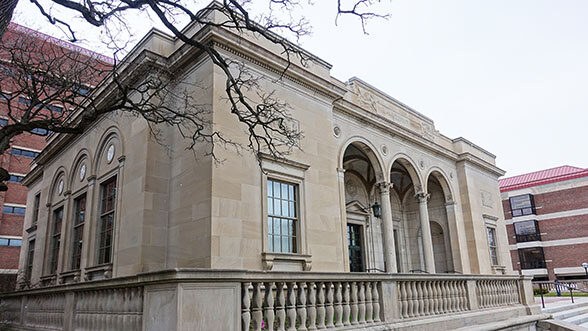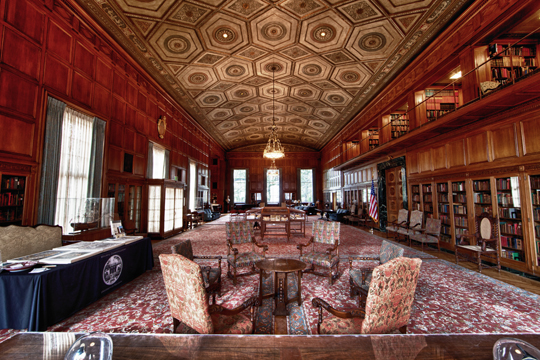An Americana sampler
For many years following its opening in 1923, entry to the William L. Clements Library (that striking Albert Kahn building next to the president’s house) was limited exclusively to the academic elite. Only about a dozen scholars per year gained clearance to study its collection of pre-20th century Americana.Over the last few decades, though, the library has begun to open its doors to a broader audience. And as part of an effort to enhance accessibility and increase the use of its collections, the library just completed a 2.5-year, $17-million renovation and expansion. Today, the library encourages students and scholars of all academic levels to engage with its ever-growing treasure trove.
“We’re thrilled to welcome people back to a space that we’re very proud of,” says Clements Library director, J. Kevin Graffagnino. “There are many alumni who studied here and have probably never had the opportunity to step inside, which is something we really want to change.”
A magical place
A passion realized
Designed by Michigan architect Kahn, the Clements Library is a landmark on U-M’s central campus that houses one of the most comprehensive collections of early American history in the world.
Kahn designed the building in the Italian Renaissance style, based on Vignola’s casino for the Villa Farnese, ca. 1587, in Capraola, Italy. The stunning interior suggests an upscale men’s club or fine urban residence, with a high vaulted ceiling, symmetrical alcoves, and a second-story balcony. Even the windows feature elegant detail.
Its name comes from the building’s benefactor, William L. Clements, an Ann Arbor native, U-M alumnus (1882) and former regent of the University who made his fortune supplying equipment for the construction of the Panama Canal and other major engineering projects at the turn of the century.
As his personal wealth grew, so did his passion for history. Clements began collecting the rare books and manuscripts that make up the heart of the existing collection. On almost any aspect of the early American experience — military history, government, religion, gender and ethnicity, culinary history, the creative arts, and exploration — the library’s collection of original primary source documents is among the best in the world.
Holdings are particularly strong in material relating to the American Revolution. Mr. Clements found the descendants of many of they key players in the Revolution (Lord Shelburne, General Sir Henry Clinton, General Nathanael Greene, and others), bought their ancestors’ papers, and brought them to Ann Arbor.
Other highlights resulting from more than 90 years of collecting at the Clements include documents relating to the exploration and discovery of North America, Native American history, colonial wars for conquest, the American Civil War and the anti-slavery movement, and the move westward.
Modern history
While minor improvements had occurred since the library’s original opening date in 1923, the building and its mechanical systems have never had a comprehensive upgrade.
The recent renovation included updates to the building’s plumbing, wiring, climate control, fire suppression, and security systems, as well as improvements to all three floors of the building.
Most notable was the construction of a two-level underground addition that includes an extra 3,000 square feet of climate-controlled storage space, which will allow most of the collection to stay securely on site.The lower level, which was completely renovated, provides enhanced curatorial offices, collections and preservation work spaces, meeting rooms, and a larger room to be used for class visits, lectures, and larger meetings.
The renovation included only minor changes to the first floor, which is known for its iconic Great Room that was formally named the “Avenir Foundation Room” in May 2013 in recognition of the foundation’s generous $6 million project grant.
“This room — easily one of the most beautiful on campus — will become the main reading room for those working with the collection,”Graffagnino says. “We’ve made the necessary adjustments so that researchers and scholars, who used to work on the lower level of the building, will be able to enjoy the magnificent space each time they come to study.”
One-half of the first floor space will serve researchers as the reading room, while the other half will serve as space for rotating exhibitions and the display of their recently acquired 1851 Columbian printing press.





Rhonda Lamberg - 1987 School of Dentistry
This is such great news that the William L. Clements Library will be opened to students and alumni!! Thank you for the very informative article. The library has been a focus of my curiousity when I attended The U of M and with every visit to the campus. It was so enjoyable to learn of my daughter’s interest and curiosity to know “what is behind those walls” as she walks by, as a student, presently!
I was hopeful that you could keep me posted on the hours of operation that may allow my daughter and me to step inside and explore the many holdings of this most beautiful library. Many thanks, Rhonda Lamberg, D.D.S.
Reply
Paul Hansknecht - 1967
My dear friend Mark Davis (now deceased) and I visited the Clements several years ago when very few knew of the change to an “open door” policy. Director Graffagnino was most gracious and granted us a personal review of the museum’s Civil War artifacts. We were thrilled, astounded, and overwhelmed. Let me amend that: the previous sentence was true the moment we walked into the Great Hall, and only increased as our visit progressed.
A visit is worthwhile if only to admire the interior, but becomes a visit to a long-inaccessible gold mine if your interests include Americana, 1492 – 1900.
Reply
Joel Nydahl - 1962, 1974
At what days and times is the Clements Library open? Does one need advanced or special permission?
Reply
Deborah Holdship
Here is the link to the Clements regarding access to the library. http://clements.umich.edu/hours.php.
Reply
Daniel Hunsberger - 1975
I loved visiting the Clements Library when I was a student. My first visit was as a sopping wet freshman who sought refuge in the entryway from a downpour. I hazarded a peek inside and was beckoned in by a kindly staff member. Still dripping from the deluge, I stayed just within the the doorway until the storm had abated. Surveying the interior from that spot has fixed an enduring image and sentiment within me. I was awed. Later visits gave me an appreciation of The University of Michigan’s dedication to providing students and researchers world-class access to historical records that I still find remarkable. When in Ann Arbor, I do try to make a stop at Clements, and once in a while my passing by has happily coincided with the Library’s open hours.
Reply
Matthew Zivich - B.S. in Design, 1960
As an undergraduate at Michigan, I was unaware of the Clements Library though I lived only a couple of blocks away. It was another imposing academic structure that seemed more forbidding than welcoming to a young art student. But now, more recently, I’ve finally overcome my shyness while investigating a personal interest in American history. Clements Library has a Civil War era, City Directory for Washington, D.C. that was an amazing find for me. I was able to peruse this booklet at my leisure, and fascination to discover there was actually an art supply store located in the Capitol at the time.
Reply
Judy Stonehill Labensohn - 1967
I lived across the street from the William Clements Library in Martha Cook (1965-66) and majored in American Culture. I used to sit at a table in the library and pine over the rare books that I was not allowed to touch. I so wanted to read the exploration narratives of the west. Since the glass doors of the bookshelves were locked, I left Ann Arbor and moved to Jerusalem. Maybe I could come back this August and look at your Hebrew collection? This would be so meaningful for me. Maybe I can still get my PhD…
Reply
Rebecca Johnson - MILS '88
It was a privilege to work on archival management seminar assignments in the Clements when working on my MILS. This is a stellar collection and great to make it better known to everyone in UM community.
Reply
Barbara Biggins - 1969
I graduated with a BA in History – American History. Why on earth were we not told about this collection? I can’t imagine how excited I would have been to have the opportunity to study there. It saddens me that my experience could have been so much richer than it was…
Reply